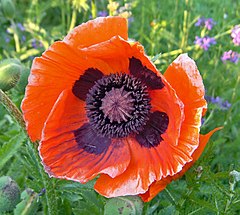Oriental poppy
| Papaver orientale subsp. var. | Oriental poppy | |||||||||||||||||||||||||||||||||||||||||||||||||||||||
|---|---|---|---|---|---|---|---|---|---|---|---|---|---|---|---|---|---|---|---|---|---|---|---|---|---|---|---|---|---|---|---|---|---|---|---|---|---|---|---|---|---|---|---|---|---|---|---|---|---|---|---|---|---|---|---|---|

|
|
| ||||||||||||||||||||||||||||||||||||||||||||||||||||||
| ||||||||||||||||||||||||||||||||||||||||||||||||||||||||
Papaver orientale or Oriental poppy is a perennial poppy of the genus Papaver.
Aside from its natural brilliant orange-scarlet, since the later 19th century selective breeding for gardens has created a range of colors from clean white with eggplant-black blotches ("Barr's White" is the standard against which other whites are measured), through clear true pinks and salmon pinks to a deep maroon.
Oriental poppies throw up a mound of handsome, finely cut hairy foliage in spring. After flowering the foliage dies away entirely, a property that allows their survival in the summer drought of Central Asia. Late-developing plants should be planted nearby to fill the developing gap. Fresh leaves appear with autumn rains.
| Standard Cyclopedia of Horticulture |
|---|
|
Papaver orientale, Linn. Oriental Poppy. Plants grow 3—4 ft. high, perennial, stiff-hairy, and bear fls. sometimes 6 in. or more across: lvs. hispid, pin-nately parted; lobes oblong-lanceolate, the upper lobes coarsely serrate and the lower incise-dentate: petals sometimes 6, obovate, narrowed below, scarlet with blackish base: caps, obovate, with a flat disk; stigmatic rays 13-15. Medit. region to Persia.—A popular perennial, new in many forms. The petals are originally apparently scarlet with a black spot. It was not until late in the 80's of the past century that this species made a decided break in color. A considerable class of hybrids with P. bracteatum has arisen which extends the color range through several shades of red to orange, salmon, and pale pink. Some are unspotted, some are adapted to cutting, and doubling has made some progress. Among the Latin names of varieties belonging to this class are grandiflorum, hybridum, immaculatum, nanum, splendens, Parkmanii, plenum, semi-plenum, and Sintenisii. Several have received common or personal names. Possibly some of these names belong rather with P. bracteatum.—Oriental poppies are better divided after blooming, in late July, or Aug., when they are dormant; but the roots should not be disturbed if the best bloom is expected the following season. They always grow in the autumn, and these divided plants would start away and make good growth. If divided in spring, they would not recover in time to bloom. Any extra-good variety may be increased largely by cutting the roots into short pieces. This also is best accomplished in summer. No plant is more brilliant in late spring or early summer than the oriental poppy, with its large fls., silken petals and flaming colors, although its season of bloom is short. CH
|
Cultivation
In the late summer, the oriental poppy becomes dormant. Protect the plant in the winter with mulching. The flower originated in Asia with a hardiness zone of 3-8 average. It usually thrives in light calcarous soil and in full sun or part shade.
Cut the stem of the flower off if you want a second flower, unless you want to keep the seeds.
Be careful not to over-water.
Propagation
Sow seeds after potential of frost when soil has thoroughly warmed. The seeds should be sown at a depth of about one cm, The average temperature should be approximately 70 °F (21 °C) for planting. Oriental Poppies do not handle transplanting well. Germination period is 10–20 days.
Divide plants in Augustsn.
Pests and diseases
Species
Gallery
If you have a photo of this plant, please upload it! Plus, there may be other photos available for you to add.
References
- Standard Cyclopedia of Horticulture, by L. H. Bailey, MacMillan Co., 1963
External links
- w:Oriental poppy. Some of the material on this page may be from Wikipedia, under the Creative Commons license.
- Oriental poppy QR Code (Size 50, 100, 200, 500)


